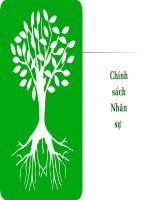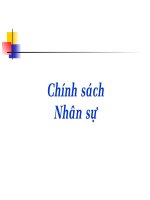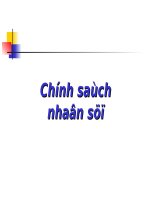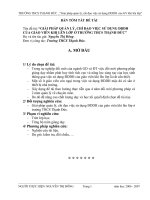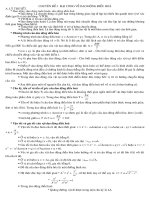DDDH SGK buổi 9
Bạn đang xem bản rút gọn của tài liệu. Xem và tải ngay bản đầy đủ của tài liệu tại đây (313.29 KB, 3 trang )
PRO 3M/3MPLUS – ƠN LUYỆN TỒN DIỆN CHO KÌ THI TỐT NGHIỆP THPT QUỐC GIA
Biên soạn: Cô Vũ Thị Mai Phương – Ngoaingu24h.vn
TÀI LIỆU ĐI KÈM LIVESTREAM
LUYỆN ĐỌC ĐIỀN - ĐỌC HIỂU ( BUỔI 11)
Theo dõi LIVESTREAM ĐỘC QUYỀN của cơ vào lúc
20h30 ngày 28/11 duy nhất trên khóa học PRO 3MPLUS
Cô Vũ Thị Mai Phương
ai
:T
ge
Pa
Read the following passage and mark the letter A, B, C, or D on your answer sheet to indicate the
correct word or phrase that best fits each of the numbered blanks from 1 to 5.
It is true that keeping fit will benefit a person’s health in many ways. It has become clear in recent
years, that a large number of people are doing less and less exercise, and this is now causing (1) ______
serious illnesses, putting a strain on doctors and hospitals. However, some experts believe that too much
exercise can do just as much damage. Although it is true that moderate exercise such as walking can be
very beneficial to a person’s health, it is not the only one factor (2) ______ keeps us healthy. Diet is also
extremely important, nd I would argue that it is probably even more important than exercise, although the
ideal is for both of these factors to work together. It seems to me that many people are unwilling to put in
the effort required to become fitter.
(3) ______, too much exercise can also cause problems. So, people are (4) ______ to take moderate
exercise and eat moderately healthily rather than embarking on extreme diets and training. In too many
instances, ultra–fit people have had heart attacks or dropped down dead.
In all, governments need to find ways of motivating people to (5) ______responsibility for their own
health. People need to realize that eating healthy food does not have to cost a fortune, nor is it difficult to
prepare healthy meals themselves. People need to be better educated about their health.
Question 1: A. much
B. any
C. many
D. other
Question 2: A. who
B. when
C. which
D. what
Question 3: A. For example
B. However
C. Therefore
D. In fact
Question 4: A. encouraged
B. discouraged
C. courage
D. encouragement
Question 5: A. do
B. make
C. give
D. take
eu
Li
K
a
ho
ay
H
oc
H
n
ie
M
im
iK
Ph
Read the following passage and mark the letter A, B, C, or D on your answer sheet to indicate the
correct answer to each of the questions from 6 to 10.
These following tips may help you make a good impression on your job interviewer during the
interview: Before entering enquire by saying, "May I come in sir/madam?". If the door was closed before
you entered, make sure you shut the door behind you softly.
Look at the interviewer and confidently say 'Good day sir/madam'. If the interviewer wants to shake
hands, then offer a firm grip first maintaining eye contact and a smile.
Seek permission to sit down. If the interviewer is standing, wait for them to sit down first before you
take your seat.
An alert interviewee would diffuse the tense situation with light-hearted humour and immediately set
rapport with the interviewer. The interviewer normally pays more attention if you display an enthusiasm
in whatever you say. This enthusiasm comes across in the energetic way you put forward your ideas.
You should maintain a cheerful disposition throughout the interview. A little humour or wit thrown in the
discussion occasionally enables the interviewer to look at the pleasant side of your personality.
an
V
KHĨA HỌC PRO3M/PRO3MPLUS – CHINH PHỤC ĐIỂM 9+ MƠN TIẾNG ANH CÙNG CÔ VŨ MAI PHƯƠNG
PRO 3M/3MPLUS – ƠN LUYỆN TỒN DIỆN CHO KÌ THI TỐT NGHIỆP THPT QUỐC GIA
Biên soạn: Cô Vũ Thị Mai Phương – Ngoaingu24h.vn
ai
:T
ge
Pa
You must maintain eye contact with the interviewer. This shows your self-confidence and honesty.
Many interviewees while answering questions, tend to look away. This conveys you are concealing your
own anxiety, fear and lack of confidence. Maintaining an eye contact is a difficult process. As the
circumstances in an interview are different, the value of eye contact is tremendous in making a personal
impact.
Interviewers appreciate a natural person rather than an actor. It is best for you to talk in natural manner
because then you appear genuine.
Question 6: What is the main idea of the passage?
A. Tips to make a good impression when attending job interview
B. The importance of eye contact when interviewing
C. Handshake in the beginning of an interview is essential
D. How humorous you should be in a job interview
Question 7: Which of the following is TRUE about advice for an interviewee as stated in the passage?
A. You should slam the door after entering the room.
B. You don’t need to ask for a permission before sitting.
C. Eye contact is necessary in a job interview.
D. Shaking hands is a must in a job interview.
Question 8: The word “rapport” in paragraph 4 mostly means ______.
A. long conversation
B. tense situation
C. good impression D. friendly relationship
Question 9: According to the passage, things advised in a job interview do not include ______.
A. lack of confident
B. cheerful disposition
C. honesty
D. sense of humour
Question 10: The word “This” in the last paragraph refer to ______.
A. personality
B. eye contact
C. interviewer
D. self-confidence
eu
Li
K
a
ho
H
oc
H
ay
Read the following passage and mark the letter A, B, C, or D on your answer sheet to indicate the
correct answer to each of the questions from 11 to 17.
While most desert animals will drink water if confronted with it, for many of them the opportunity
never comes. Yet all living things must have water, or they will expire. The herbivores find it in desert
plants. The carnivores slake their thirst with the flesh and blood of living prey. One of the most remarkable
adjustments, however, has been made by the tiny kangaroo rat, who not only lives without drinking but
subsists on a diet of dry seeds containing about 5% free water. Like other animals, he has the ability to
manufacture water in his body by a metabolic conversion of carbohydrates. He is notable for the
parsimony with which he conserves his small supply by every possible means, expending only minuscule
amounts in his excreta and through evaporation from his respiratory tract.
Investigation into how the kangaroo rat can live without drinking water has involved various
experiments with these small animals. Could kangaroo rats somehow store water in their bodies and
slowly utilize these resources in the long periods when no free water is available from dew or rain? The
simplest way to settle this question was to determine the total water content in the animals to see if it
decreases as they are kept for long periods on a dry diet. If they slowly use up their water, the body should
become increasingly dehydrated, and if they begin with a store of water, this should be evident from an
initial high-water content. Results of such experiments with kangaroo rats on dry diets for more than 7
weeks showed that the rats maintained their body weight. There was no trend toward a decrease in water
content during the long period of water deprivation. When the kangaroo rats were given free access to
water, they did not drink water. They did nibble on small pieces of watermelon, but this did not change
appreciably the water content in their bodies, which remained at 66.3 to 67.2 during this period.
n
ie
M
im
iK
Ph
an
V
KHÓA HỌC PRO3M/PRO3MPLUS – CHINH PHỤC ĐIỂM 9+ MÔN TIẾNG ANH CÙNG CÔ VŨ MAI PHƯƠNG
PRO 3M/3MPLUS – ƠN LUYỆN TỒN DIỆN CHO KÌ THI TỐT NGHIỆP THPT QUỐC GIA
Biên soạn: Cô Vũ Thị Mai Phương – Ngoaingu24h.vn
ai
:T
ge
Pa
This is very close to the water content of dry-fed animals (66.5), and the availability of free water,
therefore, did not lead to any “storage” that could be meaningful as a water reserve. This makes it
reasonable to conclude that physiological storage of water is not a factor in the kangaroo rat's ability to
live on dry food.
(Adapted from “ the land of the sun” by Lincoln Barnett)
Question 11: What is the main idea of this article?
A. Kangaroo rats and it’s life on dry food
B. Water in the desert for animals
C. Desert life of kangaroo rat
D. Physiological experiments on animals
Question 12: The word “expire” in paragraph 1 is closest in meaning to ______.
A. weaken
B. die
C. shrink
D. dehydrate
Question 13: The word “it” in paragraph 1 refer to ______.
A. a living thing
B. the desert C. the opportunity D. water
Question 14: Which of the following is NOT true about the kangaroo rat, according to the passage?
A. It uses available water in the body effectively.
B. It lives without drinking water.
C. It breathes slowly and infrequently.
D. It manufactures water internally.
Question 15: According to paragraph 2, what is the result of the experiments with kangaroo rats?
A. Kangaroo rats store water for use during dry periods.
B. Kangaroo rats took advantage of free access to water.
C. Its body weight doesn’t change significantly due to the lack of water or accessibility to water.
D. A dry diet seems detrimental to the kangaroo rat's health.
Question 16: The word “deprivation” in paragraph 2 is closest in meaning to ______.
A. shortage
B. advantage
C. coverage
D. shrinkage
Question 17: According to the passage, what allows desert animals to exist with little or no water?
A. Their less need for water than other animals
B. Many opportunities for them to find water
C. Their ability to eat plants
D. Their ability to adjust to the desert environment
eu
Li
K
a
ho
ay
H
oc
H
n
ie
M
im
iK
Ph
an
V
KHÓA HỌC PRO3M/PRO3MPLUS – CHINH PHỤC ĐIỂM 9+ MÔN TIẾNG ANH CÙNG CÔ VŨ MAI PHƯƠNG
